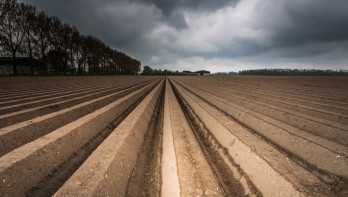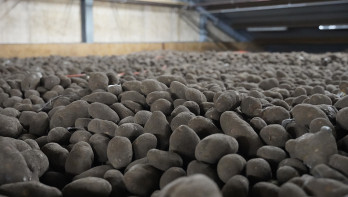Analysis Potatoes
Potato world finds itself in uncharted territory
In the Western European countries, the potato harvest is entering its final chapter. In many places, the harvesting has proceeded relatively smoothly, despite the often late planting dates. Sometimes the yields are satisfactory, but just as often disappointing. The total harvest size could break all records, putting the sector in uncharted territory. How many potatoes can the factories actually process?
The ingredients for a top harvest were present at the start of this season with a significantly expanding area in the EU-4. No one talks about the alleged seed potato shortage anymore, although the consequences are certainly noticeable in the field. Especially in the diversity of varieties. The quality of the seed potatoes has been a bigger issue, which has certainly cost yield. Also, consider seed potatoes that were cut and exposed to a lot of water, leading to rotting. Disease control required all hands on deck this summer.
Local water excess
Despite all the possibilities available in 2024: satellites, sensors, precision agriculture, etc., it is still hardly possible to have accurate figures available in time regarding the area and the yield. Meanwhile, it is clear how the area in the Western European countries is moving, although it is not yet definitive everywhere. Additionally, there may be fields of potatoes that were abandoned and never actually planted. The border region (roughly the area from Breda to Roermond and below from Hasselt to Antwerp) has experienced extremely heavy rainfall. It has rained almost every day since October 2023, at least that's how it feels for growers. This has left deep marks on the crops and yields.
Starting with the consumption area in the EU-4. Recently, the agricultural ministries of Germany and France have revised their figures upwards. The figures for the Netherlands are from July, and the Belgian figures (combined Flanders and Wallonia, excluding some seed potatoes) are a bit older. When you add up all the figures, you get a massive increase of 576,550 hectares. That is considerably more than the 560,000 hectares reported by NEPG in September. The increase in consumption potatoes amounts to a whopping 57,680 hectares (+11%) compared to last year. NEPG reported 519,583 hectares last year, which brings 7% more area according to their figures from September.
Yield variation in kilos
Germany and France are the only countries that have published official yield figures this autumn. The Netherlands' figures will follow at the end of October. For Belgium, it remains guesswork, or an educated guess, as the English say. In the first two countries, it is clear that the harvest is significantly above average. Planting could be done on time, especially in Germany. There is water damage in the south, but elsewhere, it was less severe. A larger area and a decent season result in significantly more kilos. The same goes for the middle and north of the Netherlands. As mentioned, the entire south, whether you are in Zeeland or South Limburg, is a different story. It's simply poor there. The Gewastour trial harvest figures for Innovator confirm this story. Yields range from 78 tons in Friesland to 30 tons in Zeeland.
In mid-September, the trial harvest figures from the VTA growers' organization were 46.5 tons per hectare net. If you calculate that for an area of 78,000 hectares, it means a consumption yield of 3.62 million tons. This is almost equal to 2022 but 15.5% more than last year's harvest (490,000 tons extra). It is 2.66% more than the five-year average.
Official figures are also not available for Belgium. Independent organizations such as Viaverda and Fiwap/Carah have trial harvest figures. These average 45 tons per hectare (for the Fontane variety). Figures for other varieties are yet to be released. If you calculate that, you get 4.61 million tons of potatoes. This is 1.5% more than last year's harvest (+68,000 tons).
1.89 million tons of extra potatoes
Mainly due to the higher yields in Germany (+9.2%) and France (+12%), the total consumption harvest in the EU-4 amounts to 24.56 million tons. This is the largest harvest ever and 8.4% more than last year's harvest. It means nearly 1.9 million tons of extra potatoes. Compared to the five-year average, the yield is 9.7% higher.
Finally, how are things in the other important potato countries? In Poland, the area has also increased, although there is debate about the accuracy of the figures. Official figures mention 193,000 hectares, while the potato sector assumes 213,000 hectares. This results in a yield range from 5.8 million tons to 6.4 million tons. The truth probably lies closer to the latter figure. Earlier this autumn, 6.8 million tons were still assumed.
There are no figures available for the United Kingdom at all. Insiders estimate 100,000 hectares, slightly more than last year. If you calculate based on the five-year average, the harvest size would be 4.5 million tons. This would mean the smallest harvest in almost fifty years.
Uncharted territory
When 23.5 million tons of potatoes were harvested in the EU-4 in 2017, it resulted in a negative market with very low prices. The potato world has changed significantly in seven years. Processing capacity has been added, and the demand for potato products continues to grow globally. Where the current limit lies for European processors remains uncertain. Perhaps it is 24.5 million tons, 25 million tons, or more. For immediate delivery, the market remains stable at the price level of €12.50. It is mainly the futures market price and physical bids, around €30 for delivery in April, that indicate confidence. This confidence is also present among buyers. They have no interest in a market and sector viewed negatively, planning to plant less next spring.
It is still too early to finalize the 2024 harvest. Particularly in Belgium, there is still a significant area to be harvested, although this also applies partially to France and the south and northeast of the Netherlands. A survey by the news site Vilt shows that about half was harvested in Belgium at the end of last week. Aviko estimates this percentage at 60% among their growers and nearly three-quarters in France and Germany. In the Netherlands, over 80% of the harvest was completed before the weekend, according to the processor. Heavy rainfall in parts of Belgium complicates harvesting, which also affects growers in Brabant and Limburg in the Netherlands. A small advantage is that temperatures are relatively high and will remain so. After a variable week, calm autumn weather returns, providing potato growers with new opportunities to bring in the final chapter of the harvest.



